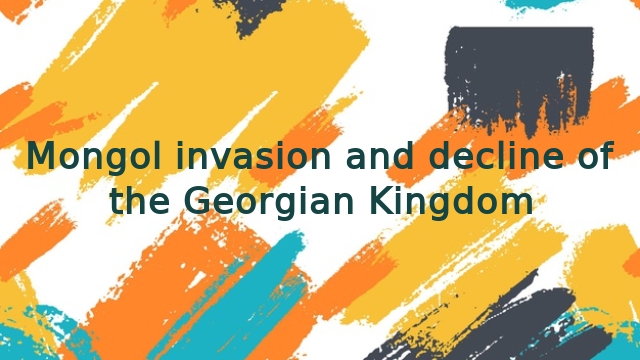
The medieval kingdom of Georgia first clashed with the advancing Mongol armies in 1220. Although these engagements were nothing but a mere reconnaissance, the Mongols returned, in 1236, in a full-scale invasion, forcing Georgia into submission by 1243. The country had to pay a heavy annual tribute and provide troops for endless Mongol campaigns. Georgian resistance, though initially passive, subsequently evolved into a series of uprisings, frequently combined with the civil strife and a power struggle between pro- and anti-Mongol factions that resulted in the decline and fragmentation of the previously powerful Georgian feudal state. The Mongol rule lasted until the late 1320s, when King George V the Brilliant, through his skillful diplomacy and military success, recovered his kingdom and restored much of its former strength and prosperity.
Initial attacks
The Mongols made their first appearance in the Georgian possessions when this latter kingdom was still in its zenith, dominating most of the Caucasus. First contact occurred early in the fall of 1220, when approximately 20,000 Mongols led by Subutai and Jebe pursued the ousted Shah Muhammad II of Khwarezmia to the Caspian Sea. With the consent of Genghis Khan, the two Mongol generals proceeded west on a reconnaissance mission. They thrust into Armenia, then under the Georgian authority, and defeated some 60,000 Georgians and Armenians commanded by King George IV “Lasha” of Georgia and his atabek (tutor) and spasalar (commander-in-chief) Iwane Mkhargrdzeli (also known as Zak’arean or Zak’arid in Armenian history writing) at the Battle of Khunan on the Kotman River. George was severely wounded in the chest. The Mongol commanders, however, were not inclined to conquer the Caucasus at that time and turned back south to Hamadan, only to return in force in January 1221. The battle at Bardav (Pardav; modern-day Barda, Azerbaijan) was indecisive and the invaders withdrew to the Caspian Sea. Then the Mongols marched to the north plundering northeastern Armenia and Shirvan enroute. This took them through the Caucasus into Alania and the South Russian steppes where the Mongols routed the Rus’-Kipchak armies at the Battle of the Kalka River (1223).
These surprise attacks left the Georgians in confusion as to the identity of their attackers: the record of one contemporary chronicler indicates that he is unaware of the nature of the attackers and does not mention them by name. In 1223, when the Mongols had seemingly deferred their plans regarding Georgia, King George IV’s sister and successor Queen Rusudan wrote in a letter to Pope Honorius III, that the Georgians had presumed the Mongols wereChristians because they fought Muslims, but they had turned out to be pagans.
Mongol conquest of Georgia
The third and final invasion of the Caucasus by the Mongols took place in 1236. This offensive, which would prove the ruin of Georgia, was preceded by the devastating conflict with Jalal ad-Din Mingburnu, a refugee shah of Khwarezmia, who had vainly demanded in 1225, that the Georgian government support his war against the Mongols. The ensuing Khwarezmian attack destroyed much of the former strength and prosperity of the Kingdom of Georgia, leaving the country largely defenseless in the face of the forthcoming Mongol conquests.
After the death of Mingburnu in 1231, the Mongols’ hands were finally free and the prominent Mongol commander Chormaqan led, in 1236, a large army against Georgia and its vassal Armenian princedoms. Most of the Georgian and Armenian nobles, who held military posts along the frontier regions submitted without any serious opposition or confined their resistance to their castles while others preferred to flee to safer areas. Queen Rusudan had to evacuate Tbilisi for Kutaisi, leaving eastern Georgia in the hands of atabek Avag Mkhargrdzeli and Egarslan Bakurtsikheli, who made peace with the Mongols and agreed to pay them tribute. The only Georgian great noble to have resisted was Iwane Jakeli-Tsikhisjvreli, prince of Samtskhe. His extensive possessions were fearfully devastated, and Iwane had to finally, with the consent of Queen Rusudan, submit to the invaders in 1238. The Mongol armies chose not to cross the Likhi Range in pursuit of the Georgian queen, leaving western Georgia relatively spared of the rampages. Rusudan attempted to gain support from Pope Gregory IX, but without any success. Atabek Avag arranged her submission in 1243, and Georgia officially acknowledged the Great Khan as its overlord. The country was forced to pay an annual tribute of 50,000 gold pieces and support the Mongols with an army.
Mongol rule in Georgia
| Modern rendition of George V “the Brilliant” | Georgia’s unity was shattered; the nobles were encouraged to rise against the crown that naturally facilitated the Mongol control of the country. In 1266, Prince Sargis Jakeli of Samtskhe (with Akhaltsikhe as the capital) was granted special protection and patronage by the khan Abaqa, thus winning virtual independence from the Georgian crown. The next (eastern) Georgian king Demetrius II the Self-Sacrificer or “the Devoted” (1259-1289), through maneuvering in the intrigues that divided the Il-khans, attempted to revive his country, but suspected in an abortive coup against Arghun Khan, he had, to save Georgia from invasion, to agree to surrender and be executed. Then the kingdom fell into near anarchy. While western Georgia maintained a perilous independence from the Ilkhans, eastern Georgia suffered from both heavy tribute and unstable political situation. In religious matters the Mongols were generally tolerant even though many churches and monasteries were taxed. An uprising by David VIII (1292-1310), though long-lasting, did not lead to the liberation of Georgia, but prompted a series of devastating punitive expeditions. The Mongols attempted to retain the control over the country by raising and bringing down the rival monarchs and by inciting the civil strife, but their influence over Georgia gradually weakened with the disintegration of the Il-khan power in Persia. George V “the Brilliant” (1299-1302, 1314-1346), a flexible and far-sighted politician, initially showed willingness to cooperate with his suzerains, but as a new tide of disorders hit the Il-khanate in 1327, he stopped payments of tribute, drove the Mongols out of the country, and reconquered much of what had been lost under his predecessors, exterminating the Mongol domination of Georgia and the Caucasus. Thus, despite the heavy burden of the century-long Mongol domination, the Georgian monarchy managed to survive and continue until the Proclamation on the Incorporation of Georgia (Kartl-Kakheti) into the Russian Empire on January 18, 1801. |





